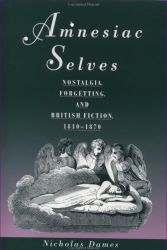Associate Professor of English and Comparative Literature, Columbia University

Links: Amnesiac Selves Nostalgia, Forgetting, and British Fiction, 1810-1870 | “Wave-Theories and Affective Physiologies: The Cognitive Strain in Victorian Novel Theories” (requires Project Muse subscription)
Research Sample: From “Wave-Theories and Affective Physiologies: The Cognitive Strain in Victorian Novel Theories,” Victorian Studies 46 (2004): 206-16 [excerpt from pp. 208-10]
By the 1850s physiology provided British and Continental psychology with the first serious alternative to associationist psychology, and with a grounding in the physical sciences that was increasingly persuasive; in the body’s reflex actions, and in the spinal cord’s relation to the cerebellum, psychologists found a basis for the study of more complex cognitions. It is therefore no unimportant fact that the most prominent writers on the novel by the mid-nineteenth century were physiologists or positivistic psychologists: G.H. Lewes, firstly, whose position atop the mid-Victorian intelligentsia (as editor, critic, and biographer) was bolstered by a series of detailed physiological investigations, such as Problems of Body and Mind (1874-79) and The Physiology of Common Life (1859-60); E.S. Dallas, The Times’s leading novel critic, whose The Gay Science (1866) attempted to marry a theory of aesthetic pleasure to contemporary researches into the unconscious or “reflex” actions of the brain; Hippolyte Taine, whose De l’intelligence (1869) offered an account of logical thought derived from physiological experimentation; Émile Hennequin, the French literary theorist whose manifesto, La critique scientifique (1888), borrowed its methodology and terminology directly from British experimental psychology; and, perhaps most notably, Alexander Bain, the acknowledged mid-Victorian authority on theories of mind, whose two key volumes, The Senses and the Intellect (1855) and The Emotions and the Will (1859), produced a synthesis between physiology and associationism whose attractiveness would only be undone by the advent of psychoanalysis. Bain’s The Emotions and the Will contains, alongside its treatment of the origin and nature of feeling, a theory of the novel that, although now forgotten, is one of the most adventurous of nineteenth-century considerations of the subject. In short, the study of the novel was a necessary adjunct, for these men and others, to the dissection of the spinal columns of small vertebrates—and the data gathered from each was presumed to have much to say to the other.
Their work is largely forgotten today because of its placement: not in the large pieces of aesthetic appreciation that the more respectable or ponderous Victorian journals occasionally published, which were almost wholly imitations of the manner and procedure of Sainte-Beuve, but instead in small squibs of periodical reviews and in now-unread physiological monographs. Genre theories of the novel were produced by an only incipiently institutionalized, loosely affiliated coterie of journalists, physiological and psychological scientists, aestheticians, and even occasionally early examples of academics in English literary studies, who—far from the image of the Victorian critic as conservative moral censor—were engaged in radical causes of various sorts and tended generally to represent the intellectual Left of their time. In their work we can find a strange alignment of disciplinary stars: a positivist physiological psychology intersected with aesthetic inquiry, which in turn linked up with a sociology of a mass reading public to produce a remarkably consistent, if locally varied, approach to theorizing the novel form. It is also forgotten because its emphasis on the modes of novel-consumption is foreign to what, after James, has gone under the name novel theory. In the wake of the great spread of the reading public, a spread each of these theorists notes, reading itself—the facts of speed, pace, attention span, engrossment, and mental concentration—became the central datum used to construct a generic theory of prose fiction, and physiology was employed as the primary methodological tool to pry open the secrets of reading.
The consequences of this odd disciplinary match are, at least for contemporary students of fictional form, far reaching; but I will here limit myself to a consideration of two of the most salient differences between the novel-as-object, or the novel-as-compositional-practice, to the novel-as-mode-of-consumption. First, a disparity between novel theory’s post-Jamesian emphasis upon epistemology (how do we know in fiction? How is information imparted, via what channels, and with what distorting effect?) and an earlier tradition’s poetics of affect (how do we feel in fiction? In what ways, and with what rhythms, does the novel ask us to feel, to pay attention, to drift?). What this will mean, as I hope to show, is a nineteenth-century interest in order, or sequence, and the affective workings of various fictional sequences, rather than the twentieth-century devotion to “point of view,” or the narrator’s relation to the fictional world. Secondly, a divergence between a consideration of the novel as an artifact—a kind of spatial form—and a consideration of the novel as a temporal form: a form whose unrolling in the time of our reading is subject to unique generic laws, laws that usually center on rhythm, and that in the work of Alexander Bain become expressed as what I will call a wave theory of novelistic affect. In general, I would suggest that this early novel theory reorients us from a world of fiction as an engine for the production of knowledge to a world of fiction as a machine for the production of affect—and, as such, reorients us toward a study of the novel that would have to take into account the ways in which our attention is requested by it, the ways in which the pace of our reading is contoured by that attention, and the size or duration of the units of comprehension which make up novel reading.
[Full text available for subscribers to Project Muse.]
